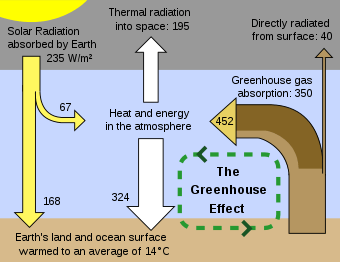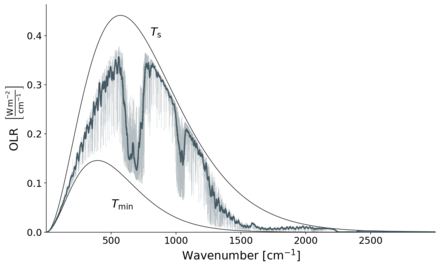Outgoing longwave radiation
Outgoing Long-wave Radiation (OLR) is electromagnetic radiation of wavelengths between 3.0 and 100 μm emitted from Earth and its atmosphere out to space in the form of thermal radiation. It is also referred to as up-welling long-wave radiation and terrestrial long-wave flux, among others. The flux of energy transported by outgoing long-wave radiation is measured in W/m2. In the Earth's climate system, long-wave radiation involves processes of absorption, scattering, and emissions from atmospheric gases, aerosols, clouds and the surface.

Over 99% of outgoing long-wave radiation has wavelengths between 4 μm and 100 μm,[1] in the thermal infrared part of the electromagnetic spectrum. Contributions with wavelengths larger than 40 μm are small, therefore often only wavelengths up to 50 μm are considered . In the wavelength range between 4 μm and 10 μm the spectrum of outgoing long-wave radiation overlaps that of solar radiation, and for various applications different cut-off wavelengths between the two may be chosen.
Radiative cooling by outgoing long-wave radiation is the primary way the Earth System loses energy. The balance between this loss and the energy gained by radiative heating from incoming solar shortwave radiation determines global heating or cooling of the Earth system (Energy budget of Earth's climate).[2] Local differences between radiative heating and cooling provide the energy that drives atmospheric dynamics.
Atmospheric energy balance

OLR is a critical component of the Earth's energy budget, and represents the total radiation going to space emitted by the atmosphere.[3] OLR contributes to the net all-wave radiation for a surface which is equal to the sum of shortwave and long-wave down-welling radiation minus the sum of shortwave and long-wave up-welling radiation.[4] The net all-wave radiation balance is dominated by long-wave radiation during the night and during most times of the year in the polar regions.[5] Earth's radiation balance is quite closely achieved since the OLR very nearly equals the Shortwave Absorbed Radiation received at high energy from the sun. Thus, the Earth's average temperature is very nearly stable. The OLR balance is affected by clouds and dust in the atmosphere. Clouds tend to block penetration of long-wave radiation through the cloud and increases cloud albedo, causing a lower flux of long-wave radiation into the atmosphere.[6] This is done by absorption and scattering of the wavelengths representing long-wave radiation since absorption will cause the radiation to stay in the cloud and scattering will reflect the radiation back to earth. the atmosphere generally absorbs long-wave radiation well due to absorption by water vapour, carbon dioxide, and ozone.[4] Assuming no cloud cover, most long-wave up-welling radiation travels to space through the atmospheric window occurring in the electromagnetic wavelength region between 8 and 11 μm where the atmosphere does not absorb long-wave radiation except for in the small region within this between 9.6 and 9.8 μm.[4] The interaction between up-welling long wave radiation and the atmosphere is complicated due to absorption occurring at all levels of the atmosphere and this absorption depends on the absorptivities of the constituents of the atmosphere at a particular point in time.[4]
Role in greenhouse effect
The reduction of the surface long-wave radiative flux drives the greenhouse effect.[7] Greenhouse gases, such as methane (CH4), nitrous oxide (N2O), water vapor (H2O) and carbon dioxide (CO2), absorb certain wavelengths of OLR, preventing the thermal radiation from reaching space, adding heat to the atmosphere. Some of this thermal radiation is directed back towards the Earth by scattering, increasing the average temperature of the Earth's surface. Therefore, an increase in the concentration of a greenhouse gas may contribute to global warming by increasing the amount of radiation that is absorbed and emitted by these atmospheric constituents. If the absorptivity of the gas is high and the gas is present in a high enough concentration, the absorption bandwidth becomes saturated. In this case, there is enough gas present to completely absorb the radiated energy in the absorption bandwidth before the upper atmosphere is reached, and adding a higher concentration of this gas will have no additional effect on the energy budget of the atmosphere.
The OLR is dependent on the temperature of the radiating body. It is affected by the Earth's skin temperature, skin surface emissivity, atmospheric temperature, water vapor profile, and cloud cover.[3]
OLR measurements
Two popular remote sensing methods used to estimate up-welling long-wave radiation are to estimate values using surface temperature and emissivity, and to estimate directly from satellite top-of-atmosphere radiance or brightness temperature.[5] Measuring outgoing long-wave radiation at the top of atmosphere and down-welling long-wave radiation at the surface is important for understanding how much radiative energy is kept in our climate system, how much reaches and warms the surface, and how the energy in the atmosphere is distributed to affect developments of clouds. Calculating the long-wave radiative flux from a surface is also a useful an easy way to assess surface temperature[8]
Outgoing long-wave radiation (OLR) has been monitored globally since 1975 by a number of successful and valuable satellite missions. These missions include broadband measurements from the Earth Radiation Balance (ERB) instrument on the Nimbus-6 and Nimbus-7 satellites;[9][10] Earth Radiation Budget Experiment (ERBE) scanner and the ERBE non scanner on NOAA-9, NOAA-10 and NASA Earth Radiation Budget Satellite (ERBS); The Clouds and the Earth's Radiant Energy System (CERES) instrument aboard NASA's Aqua and Terra satellites; and Geostationary Earth Radiation Budget instrument (GERB) instrument on the Meteosat Second Generation (MSG) satellite.
Down-welling long-wave radiation at the surface is mainly measured by Pyrgeometer. A most notable ground-based network for monitoring surface long-wave radiation is Baseline Surface Radiation Network (BSRN), which provides crucial well-calibrated measurements for studying global dimming and brightening.[11]
OLR calculation and simulation

Many applications call for calculation of long-wave radiation quantities: the balance of global incoming shortwave to outgoing long-wave radiative flux determines the Energy budget of Earth's climate; local radiative cooling by outgoing long-wave radiation (and heating by shortwave radiation) drive the temperature and dynamics of different parts of the atmosphere; from the radiance from a particular direction measured by an instrument, atmospheric properties (like temperature or humidity) can be retrieved. Calculations of these quantities solve the radiative transfer equations that describe radiation in the atmosphere. Usually the solution is done numerically by an Atmospheric radiative transfer code adapted to the specific problem.
See also
References
- Petty, Grant W. (2006). A first course in atmospheric radiation (2. ed.). Madison, Wisc.: Sundog Publ. p. 68. ISBN 978-0972903318.
- Kiehl, J. T.; Trenberth, Kevin E. (February 1997). "Earth's Annual Global Mean Energy Budget". Bulletin of the American Meteorological Society. 78 (2): 197–208. Bibcode:1997BAMS...78..197K. doi:10.1175/1520-0477(1997)078<0197:EAGMEB>2.0.CO;2.
- Susskind, Joel; Molnar, Gyula; Iredell, Lena. "Contributions to Climate Research Using the AIRS Science Team Version-5 Products". NASA. Goddard Space Flight Center. hdl:2060/20110015241.
- Oke, T. R. (2002-09-11). Boundary Layer Climates. doi:10.4324/9780203407219. ISBN 9780203407219.
- Wenhui Wang; Shunlin Liang; Augustine, J.A. (May 2009). "Estimating High Spatial Resolution Clear-Sky Land Surface Upwelling Longwave Radiation From MODIS Data". IEEE Transactions on Geoscience and Remote Sensing. 47 (5): 1559–1570. Bibcode:2009ITGRS..47.1559W. doi:10.1109/TGRS.2008.2005206. ISSN 0196-2892.
- Kiehl, J. T.; Trenberth, Kevin E. (1997). "Earth's Annual Global Mean Energy Budget". Bulletin of the American Meteorological Society. 78 (2): 197–208. Bibcode:1997BAMS...78..197K. doi:10.1175/1520-0477(1997)078<0197:eagmeb>2.0.co;2. Retrieved 2019-02-07.
- Schmidt, Gavin A.; Ruedy, Reto A.; Miller, Ron L.; Lacis, Andy A. (2010-10-16). "Attribution of the present-day total greenhouse effect". Journal of Geophysical Research. 115 (D20): D20106. Bibcode:2010JGRD..11520106S. doi:10.1029/2010jd014287. ISSN 0148-0227. S2CID 28195537.
- Price, A. G.; Petzold, D. E. (February 1984). "Surface Emissivities in a Boreal Forest during Snowmelt". Arctic and Alpine Research. 16 (1): 45. doi:10.2307/1551171. ISSN 0004-0851. JSTOR 1551171.
- Jacobowitz, Herbert; Soule, Harold V.; Kyle, H. Lee; House, Frederick B. (30 June 1984). "The Earth Radiation Budget (ERB) Experiment: An overview". Journal of Geophysical Research: Atmospheres. 89 (D4): 5021–5038. doi:10.1029/JD089iD04p05021.
- Kyle, H. L.; Arking, A.; Hickey, J. R.; Ardanuy, P. E.; Jacobowitz, H.; Stowe, L. L.; Campbell, G. G.; Vonder Haar, T.; House, F. B.; Maschhoff, R.; Smith, G. L. (May 1993). "The Nimbus Earth Radiation Budget (ERB) Experiment: 1975 to 1992". Bulletin of the American Meteorological Society. 74 (5): 815–830. Bibcode:1993BAMS...74..815K. doi:10.1175/1520-0477(1993)074<0815:TNERBE>2.0.CO;2.
- Wild, Martin (27 June 2009). "Global dimming and brightening: A review". Journal of Geophysical Research. 114 (D10): D00D16. Bibcode:2009JGRD..114.0D16W. doi:10.1029/2008JD011470. S2CID 5118399.
External links
- NOAA Climate Diagnostics Center
- NASA Earth Observatory Outgoing Heat Radiation
- Office of Satellite Data Processing and Distribution, Radiation Budget at the Wayback Machine (archived May 5, 2008)
- Meteorological Satellite Center, Japan Meteorological Agency at the Wayback Machine (archived September 27, 2007)
- Planetary Energy Balance, Physical Geography